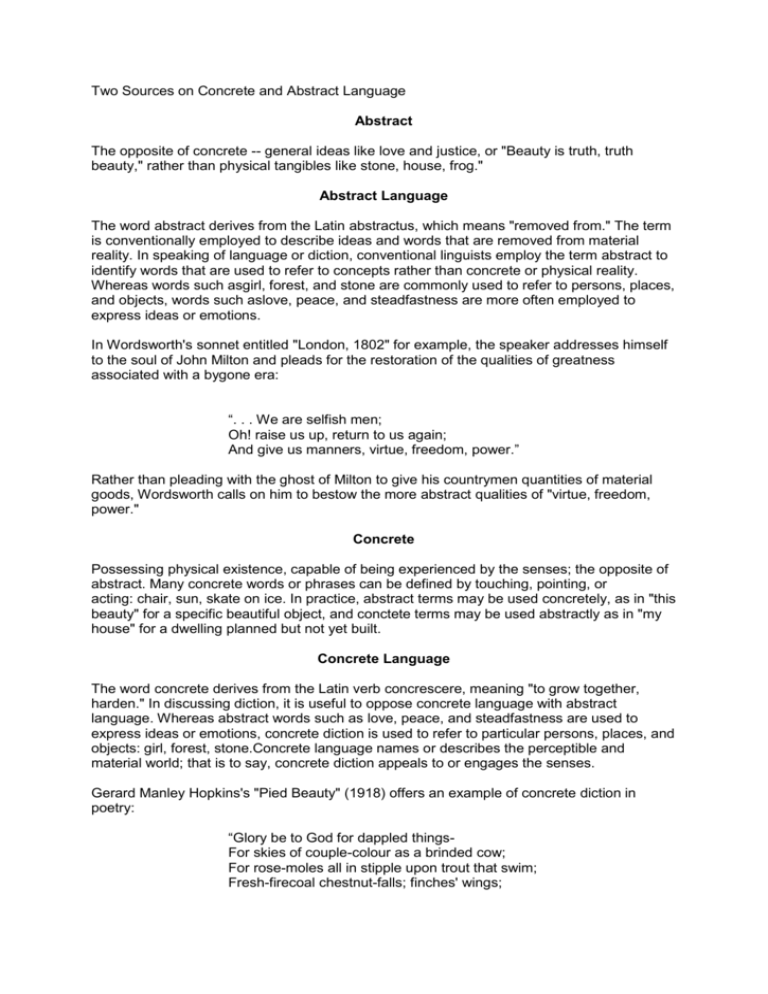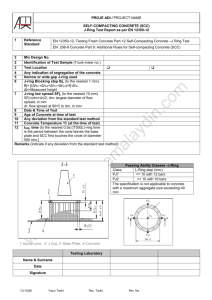Two Sources on Concrete and Abstract Language - nations
advertisement

Two Sources on Concrete and Abstract Language Abstract The opposite of concrete -- general ideas like love and justice, or "Beauty is truth, truth beauty," rather than physical tangibles like stone, house, frog." Abstract Language The word abstract derives from the Latin abstractus, which means "removed from." The term is conventionally employed to describe ideas and words that are removed from material reality. In speaking of language or diction, conventional linguists employ the term abstract to identify words that are used to refer to concepts rather than concrete or physical reality. Whereas words such asgirl, forest, and stone are commonly used to refer to persons, places, and objects, words such aslove, peace, and steadfastness are more often employed to express ideas or emotions. In Wordsworth's sonnet entitled "London, 1802" for example, the speaker addresses himself to the soul of John Milton and pleads for the restoration of the qualities of greatness associated with a bygone era: “. . . We are selfish men; Oh! raise us up, return to us again; And give us manners, virtue, freedom, power.” Rather than pleading with the ghost of Milton to give his countrymen quantities of material goods, Wordsworth calls on him to bestow the more abstract qualities of "virtue, freedom, power." Concrete Possessing physical existence, capable of being experienced by the senses; the opposite of abstract. Many concrete words or phrases can be defined by touching, pointing, or acting: chair, sun, skate on ice. In practice, abstract terms may be used concretely, as in "this beauty" for a specific beautiful object, and conctete terms may be used abstractly as in "my house" for a dwelling planned but not yet built. Concrete Language The word concrete derives from the Latin verb concrescere, meaning "to grow together, harden." In discussing diction, it is useful to oppose concrete language with abstract language. Whereas abstract words such as love, peace, and steadfastness are used to express ideas or emotions, concrete diction is used to refer to particular persons, places, and objects: girl, forest, stone.Concrete language names or describes the perceptible and material world; that is to say, concrete diction appeals to or engages the senses. Gerard Manley Hopkins's "Pied Beauty" (1918) offers an example of concrete diction in poetry: “Glory be to God for dappled thingsFor skies of couple-colour as a brinded cow; For rose-moles all in stipple upon trout that swim; Fresh-firecoal chestnut-falls; finches' wings; Landscape plotted and pierced-fold, fallow, and plough; And all trades, their gear and tackle and trim.” Hopkins clearly revels in language that appeals to the visual sense. These lines offer specific, material examples of "dappled things." The opening lines of Gary Soto's "History" (1977) offer another example of concrete diction: Grandma lit the stove. Morning sunlight Lengthened in spears Across the linoleum floor. Wrapped in a shawl, Her eyes small With sleep, She sliced papas, Pounded chiles With a stone Bought from Guadalajara. Instead of describing his subject as an early riser, Soto uses a language of specificity and sensory appeal: "Her eyes small / With sleep." Likewise, rather than merely indicating that she prepared food, the speaker describes her activities in concrete terms: "She sliced papas, / Pounded chiles / With a stone..."







